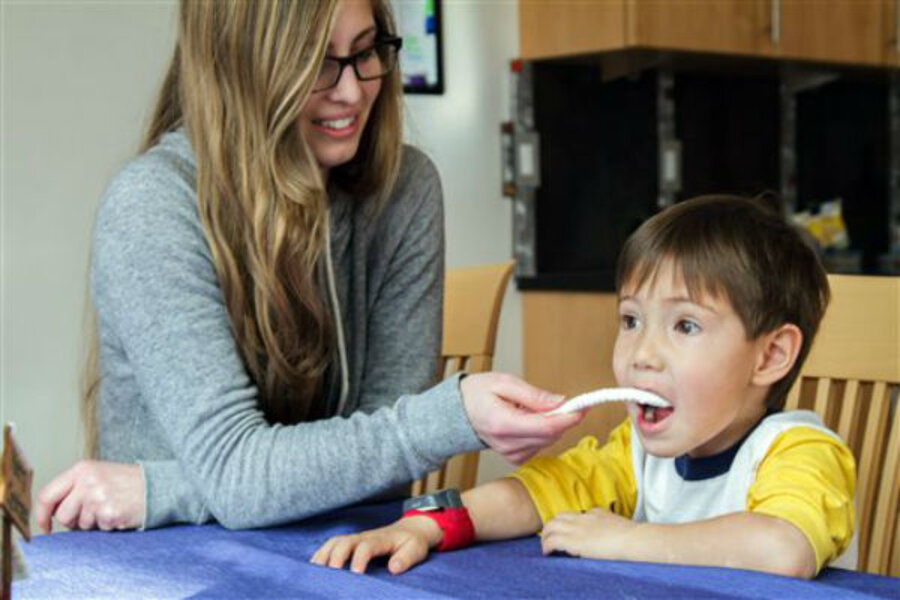Is your child's internal clock foiling your bedtime routine?
Loading...
| Washington
"Just one more story, please?" ''I need a glass of water." ''Mom, I can't sleep!"
When youngsters continually struggle to fall asleep at night, new research suggests maybe their body clock doesn't match their bedtime.
That doesn't mean tots should be up at all hours.
"Just like nutrition and exercise, sleep is critical for good health," said sleep scientist Monique LeBourgeois of the University of Colorado, Boulder, who is leading the research.
The ultimate goal is to help reset a delayed sleep clock so that young children can settle down more easily, she said. Hint: It seems to have a lot to do with light.
We all have what's called a circadian rhythm, a master biological clock, that regulates when we become sleepy, and when we're more alert. Those patterns vary with age: It's the reason teenagers are notorious for late nights and difficult-to-wake mornings.
But how does that clock work in preschoolers, who need more sleep than older kids or adults? A first-of-its-kind study tracked 14 healthy youngsters for six days to begin finding out.
The children, ages 2½ to 3, wore activity monitors on their wrists to detect when they slept. Parents kept diaries about bedtime routines.
Then on the last afternoon, researchers visited each home, dimming lights and covering windows. Then, every 30 minutes for six hours leading up to the child's appointed bedtime, they also coaxed each tot to chew on some dental cotton to provide a sample of saliva.
The reason: To test for levels of a hormone named melatonin that is key to the sleep cycle and also sensitive to light. At some point every evening, people's melatonin levels surge and a while later, they begin to feel sleepy. Among adults who sleep well, that melatonin rise tends to happen about two hours before whatever is their chosen bedtime.
For preschoolers, the new study found that on average, the melatonin surge occurred around 7:40 p.m. The children tended to be tucked in around 8:10 p.m., and most were asleep 30 minutes later, Dr. LeBourgeois reported in the journal Mind, Brain and Education.
When melatonin rose earlier in the evening, tots who hit the sack around 8 fell asleep a bit faster. But when the melatonin surge was closer to bedtime, the youngsters were more likely to fuss or make curtain calls after lights-out.
Two children in the study actually were tucked in before their rise in melatonin ever occurred, and it took them up to an hour past bedtime to fall asleep, she said.
"We don't know what that sweet spot is yet," LeBourgeois said, but the data suggest bedtime is easiest if the melatonin surge occurred at least 30 minutes earlier.
The study reinforces what doctors have long suspected is one bedtime barrier, said Jyoti Krishna, a pediatric sleep expert at the Cleveland Clinic. Other factors can disrupt a child's sleep, too, such as noise, stress or anxiety, or disrupted home routines, he cautioned.
"But this paper reminds us that, hey, there is a time that the body is more ready to sleep than at other times," Dr. Krishna said.
The National Institutes of Health says preschoolers need 11 to 12 hours of sleep each day; some typically comes from an afternoon nap.
Parents don't have melatonin tests as a guide, so Krishna advises looking for cues when setting a bedtime – yawning, rubbing eyes – and then to adjust that bedtime as the child gets older.
"The melatonin onset and our body rhythms change," Krishna said. "You can't stick to what worked two years ago with this child, because this child is now a different child."
About 25 percent of young children experience some type of sleep difficulty, including trouble settling down at bedtime, LeBourgeois said. Harried parents aside, there's concern that early-in-life bedtime frustration might lead to more persistent sleep trouble.
"Listen to your child's physiology," she advised. Some steps that might help:
–Research shows that in adults, too much light in the evening delays the melatonin surge and subsequent sleepiness. While there's no data in young children yet, LeBourgeois says dimming the lights about an hour before bedtime makes sense.
–Avoid electronics near bedtime, because they generate a specific type of light that triggers wakefulness. LeBourgeois was horrified to hear one parent offer a sleepless youngster an iPad to play with as long as the child stayed in the bedroom.
–And make sure blackout shades aren't keeping your children from getting enough morning sunlight, she said. Light in the morning also is key to keeping the biological sleep clock on schedule.
Stay tuned: With funding from the National Institute of Mental Health, LeBourgeois has begun a larger study that will track sleep patterns of 40 2-year-olds until they're 5. She'll also measure their light exposure, and periodically record their brain waves during sleep, in a bid to better understand the influence of sleep patterns on children's development.







